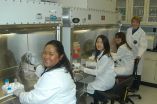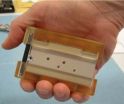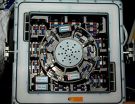HOUSTON, TX, April 22, 2014 (Press-News.org) Telling someone to "act your age" is another way of asking him or her to behave better. Age, however, does not always bring improvements. Certain cells of the immune system tend to misbehave with age, leaving the elderly more vulnerable to illness. Because these cells are known to misbehave similarly during spaceflight, researchers are studying the effects of microgravity on immune cells to better understand how our immune systems change as we age.
NASA and the National Institute on Aging, part of the National Institutes of Health, have teamed up to support research aboard the International Space Station that may one day advance medical care and quality of life for all humanity. T-Cell Activation in Aging is the first study to launch into space that is funded by the Biomedical Research on the International Space Station National Institutes of Health initiative.
It is difficult to study the genetic and molecular changes associated with aging-related immune suppression because the condition develops over decades, and the elderly often have illnesses that can complicate research studies. However, changes in the immune system--including T-cell behavior--quickly occur in space.
"One of our goals for this study is to use microgravity as a novel model system of aging to investigate the molecular mechanisms of immune suppression commonly seen in the elderly population," said Millie Hughes-Fulford, former NASA astronaut, principal investigator for the study and researcher at the University of California, San Francisco, Northern California Institute for Research and Education and the San Francisco Veterans Affairs Medical Center. "Ultimately, this could lead us to new treatment strategies for immune system dysfunction."
"This experiment's unique approach to studying molecular mechanisms that contribute to decline of T-cell function will add to our understanding of the effects of zero gravity on the immune function, as well as provide insights about immune suppression, a major issue affecting older people," said Felipe Sierra Ph.D., director of the National Institute on Aging Division of Aging Biology. "Hopefully, this will help lead to new interventions to prevent infection not only for those on space travel but also for those with compromised immune systems, including the elderly."
Our immune systems are sophisticated defense networks for our bodies that protect us from disease. Immune cells constantly patrol our bloodstreams, asking other cells that they encounter--in molecular language--"are you friend or foe?" When these cells detect an enemy, they deliver that intelligence to a specialized immune cell, known as a T-cell.
"If the immune system is like an army, then the T-cells are the generals," said Hughes-Fulford.
When news of an enemy encounter is reported to the T-cells, they activate and issue commands to rouse an army of immune cells to fight off the infection. But if the T-cells misbehave and fail to call in the troops, we get sick.
Diminished immune system function is a common problem for the elderly and for astronauts. Remarkably, several key changes in the immune systems of the elderly are the same as those found in astronauts returning from spaceflight. Impaired T-cell activation and rapid cell production are among those changes. Because spaceflight-induced and aging-related immune suppression share these key characteristics, researchers expect results from this study will be relevant for the general population.
Hughes-Fulford's research seeks to find how exposure to microgravity can mimic aging for immune cells and to reveal the biochemical mechanisms that underlie immune system dysfunction. This knowledge may be applied to develop treatments not only for immune suppression but also for inflammatory diseases in which the immune system misbehaves by overreacting rather than failing to act.
Hughes-Fulford's most recent spaceflight study--Leukin-2--was designed to identify which aspects of spaceflight disrupt the immune system. Prior research showed that T-cell activation is severely impaired in space. Leukin-2 was the first study to compare T-cell activation in microgravity side-by-side with artificial gravity control samples in a centrifuge aboard the space station. "Our results from the Leukin-2 study demonstrated for the first time that gravity affects gene expression and early activation of T-cells," said Hughes-Fulford.
On Earth, scientists go to a lot of effort to simulate diseases in the laboratory so they can study them and develop ways to prevent or treat them. After a relatively brief trip to the space station in the Leukin-2 study, unmodified T-cells from healthy donors mimicked T-cells from elderly immunosuppressed individuals. In other words, Hughes-Fulford found that exposure to microgravity can simulate aging.
T-Cell Activation in Aging builds upon on the insights gained from the Leukin-2 study by providing new information about the biochemical mechanisms of T-cell activation.
Hughes-Fulford's science team loaded samples of human T-cells from healthy donors into specialized experiment containers at NASA's Kennedy Space Center in Florida in preparation of T-Cell Activation in Aging's launch on April 18. The investigation flew to the station aboard the third commercial resupply mission of SpaceX's Dragon spacecraft. Space station crew members placed the samples into the Kubik incubator facility in the European Space Agency's (ESA) Columbus laboratory.
During the study, some samples will be placed in a centrifuge, which can create artificial gravity, and will serve as a control to the microgravity samples. An activator will be added to the experiment containers to signal news of an infection for the T-cells. Subsequently, a fixative that prevents the cells from changing further will stabilize the samples for post-flight analysis. The samples will return to Earth aboard Dragon and be delivered to Hughes-Fulford's science team approximately 30 days after launch.
The National Institute on Aging is the sponsoring agency for T-Cell Activation in Aging. NASA's Ames Research Center in Moffett Field, Calif., is the integration partner providing science team support. ESA is the payload developer and is providing investigation hardware, payload integration and operations support for the mission.
Once the samples return to Earth, the science team will analyze the space-flown and ground-control samples for changes in gene expression and protein synthesis. They also will examine the samples for a type of molecule known as microRNA--a small RNA molecule that affects cellular behavior but does not encode a protein. During the Leukin study, researchers saw gravity-induced changes in at least one type of microRNA. The T-Cell Activation in Aging investigation will enable the team to follow up on these findings. The role that microRNAs play in immune system function--on Earth or in space--is presently unknown.
MicroRNAs are promising candidates for pharmaceutical development as they are known to regulate genes. "One of our research goals is to find and test new pathways for regulation of the immune system involving microRNAs," said Hughes-Fulford. "Once we pinpoint the right targets, we can develop drugs to turn up the immune response for immunosuppressed patients or turn down the response to alleviate autoimmune or inflammatory disease. The switch goes both ways."
The researchers will apply their findings from this spaceflight investigation to future ground studies of T-cells from elderly individuals.
Microgravity research can help us study biological processes that naturally happen as we age. As we all are aging, we all stand to benefit from new strategies to keep our immune defense systems behaving at their best. We may not stop the flow of time, but with advances made possible by studies like this, there is hope for extending the time we do have for healthy lives here on Earth.
by Gianine M. Figliozzi
Space Biosciences Division
NASA's Ames Research Center
For an Immune Cell, Microgravity Mimics Aging
T-Cell Activation in Aging will study the effects of microgravity on immune cells to better understand how our immune systems change as we age.
2014-04-22
ELSE PRESS RELEASES FROM THIS DATE:
Watch Former NFL Player Mark Walczak Sleep! Overnight Sleep Study at the American Sleep & Breathing Academy Conference Has Former AZ Cardinals NFL Player Mark Walczak Sleeping For A Cause
2014-04-22
Former Arizona Cardinals NFL player, and Pro-Player Health Alliance Sleep Apnea Awareness Advocate, Mark Walczak, undergoes a live public sleep study presented by the American Sleep and Breathing Academy to help raise awareness for sleep disorder treatment and education. ASBA's first public sleep study will be webcast alongside a clinical rotation for sleep health professionals and will be open for observation by registered attendees of the American Sleep & Breathing Academy's Sleep and Wellness 2014: A Conference for Healthcare Professionals, held at the Radisson Ft. ...
CT measures potentially dangerous arterial plaque in diabetic patients
2014-04-22
OAK BROOK, Ill. – Imaging of the coronary arteries with computed tomography (CT) angiography provides an accurate assessment of arterial plaque and could have a dramatic impact on the management of diabetic patients who face a high risk of heart attacks and other cardiovascular events, according to a new multicenter study published online in the journal Radiology.
Plaque that forms in the arterial walls can restrict blood flow and, in some cases, rupture, leading to potentially fatal heart attacks. There is considerable evidence that calcified, or stable, plaque, is less ...
Acute respiratory distress syndrome: Study IDs surgical patients at risk
2014-04-22
ROCHESTER, Minn. — Acute respiratory distress syndrome is a leading cause of respiratory failure after surgery. Patients who develop the lung disorder postoperatively are at higher risk of dying in the hospital, and those who survive the syndrome may still bear its physical effects years later. A Mayo Clinic-led study is helping physicians better identify patients most at risk, the first step toward preventing this dangerous and costly surgical complication. They found nine independent risk factors, including sepsis, high-risk aortic vascular surgery, high-risk cardiac ...
Cow manure harbors diverse new antibiotic resistance genes
2014-04-22
Manure from dairy cows, which is commonly used as a farm soil fertilizer, contains a surprising number of newly identified antibiotic resistance genes from the cows' gut bacteria. The findings, reported in mBio® the online open-access journal of the American Society for Microbiology, hints that cow manure is a potential source of new types of antibiotic resistance genes that transfer to bacteria in the soils where food is grown.
Thousands of antibiotic resistance (AR) genes have already been identified, but the vast majority of them don't pose a problem when found in ...
Annals of Internal Medicine tip sheet for April 22, 2014
2014-04-22
1. Health care leaders and advocates call for patient-centered 'revolution' in medical education
Patients and families should be included in the training environment not only as the recipients of care, but also as teachers and evaluators of residents and students, according to a new commentary being published in Annals of Internal Medicine. “Patients and families can provide invaluable insights and perspectives for changing and improving physician training programs,” says lead author Steven E. Weinberger, MD, FACP, executive vice president and chief executive officer ...
Narrowing of neck artery without warning may signal memory and thinking decline
2014-04-21
PHILADELPHIA – For the first time, researchers have demonstrated that narrowing of the carotid artery in the neck without any symptoms may be linked to problems in learning, memory, thinking and decision-making, compared to people with similar risk factors but no narrowing in the neck artery, according to a study released today that will be presented at the American Academy of Neurology's 66th Annual Meeting in Philadelphia, April 26 to May 3, 2014.
"To date, the focus of diagnosis and management of carotid artery blockages has been prevention of stroke since that was ...
Study examines patient care patterns in Medicare accountable care organizations
2014-04-21
Bottom Line: A third of Medicare beneficiaries assigned to accountable care organizations (ACOs) in 2010 or 2011 were not assigned to the same ACO in both years and much of the specialty care received was provided outside the patients' assigned ACO, suggesting challenges to achieving organizational accountability in Medicare.
Author: J. Michael McWilliams, M.D., Ph.D., of Harvard Medical School and Brigham and Women's Hospital, Boston, and colleagues.
Background: ACOs are intended to foster greater accountability in the traditional fee-for-service Medicare program by ...
False-positive mammograms associated with anxiety, willingness for future screening
2014-04-21
Bottom Line: Mammograms with false-positive results were associated with increased short-term anxiety for women, and more women with false-positive results reported that they were more likely to undergo future breast cancer screening.
Author: Anna N.A. Tosteson, Sc.D., of the Dartmouth Institute for Health Policy and Clinical Practice, Lebanon, N.H., and colleagues.
Background: A portion of women who undergo routine mammogram screening will experience false-positive results and require further evaluation to rule out breast cancer.
How the Study Was Conducted: The ...
Increased prevalence of celiac disease in children with irritable bowel syndrome
2014-04-21
There appears to be an increased prevalence of celiac disease among children with irritable bowel syndrome (IBS).
Recurrent abdominal pain affects 10 percent to 15 percent of school-aged children. The prevalence of celiac disease is as high as 1 percent in European countries and patients can present with a wide spectrum of symptoms, including abdominal pain, although the disease is often asymptomatic.
The authors assessed the prevalence of celiac disease in 992 children with abdominal pain-related disorders: IBS, functional dyspepsia (indigestion) and functional abdominal ...
Today's Antarctic region once as hot as California, Florida
2014-04-21
Parts of ancient Antarctica were as warm as today's California coast, and polar regions of the southern Pacific Ocean registered 21st-century Florida heat, according to scientists using a new way to measure past temperatures.
The findings, published the week of April 21 in the Proceedings of the National Academy of Sciences, underscore the potential for increased warmth at Earth's poles and the associated risk of melting polar ice and rising sea levels, the researchers said.
Led by scientists at Yale, the study focused on Antarctica during the Eocene epoch, 40-50 million ...
LAST 30 PRESS RELEASES:
University of Phoenix College of Doctoral Studies releases white paper on AI-driven skilling to reduce burnout and restore worker autonomy
AIs fail at the game of visual “telephone”
The levers for a sustainable food system
Potential changes in US homelessness by ending federal support for housing first programs
Vulnerability of large language models to prompt injection when providing medical advice
Researchers develop new system for high-energy-density, long-life, multi-electron transfer bromine-based flow batteries
Ending federal support for housing first programs could increase U.S. homelessness by 5% in one year, new JAMA study finds
New research uncovers molecular ‘safety switch’ shielding cancers from immune attack
Bacteria resisting viral infection can still sink carbon to ocean floor
Younger biological age may increase depression risk in older women during COVID-19
Bharat Innovates 2026 National Basecamp Showcases India’s Most Promising Deep-Tech Ventures
Here’s what determines whether your income level rises or falls
SCIE indexation achievement: Celebrate with Space: Science & Technology
Children’s Hospital Colorado performs region’s first pediatric heart and liver dual organ transplant
Australian team discover why quantum computers have memory problems over time
What determines the fate of a T cell?
Candida auris: genetic process revealed which could be treatment target for deadly fungal disease
Groundbreaking discovery turns household plastic recycling into anti-cancer medication
Blocking a key inflammatory pathway improves liver structure and vascular function in cirrhosis, study finds
Continuous spread: Raccoon roundworm detected in nine European countries
HKUST Engineering researchers developed a novel photodetector to enhance the performance of on-chip light monitoring
Strategic river sensors could have forewarned of Texas Camp flood disaster
Drone sampling of whale breath reveals first evidence of potentially deadly virus in Arctic
Roman soldiers defending Hadrian’s Wall infected by parasites, study finds
Pinochet’s prisoners were tormented with music but still found solace in it, a new book reveals
Fertility remains high in rural Tanzania despite access to family planning
AI-assisted device can improve autism care access
Kinetic careers
Uncovering how parasitic plants avoid attacking themselves to improve crop resistance
Nanoparticle vaccine strategy could protect against Ebola and other deadly filoviruses
[Press-News.org] For an Immune Cell, Microgravity Mimics AgingT-Cell Activation in Aging will study the effects of microgravity on immune cells to better understand how our immune systems change as we age.


